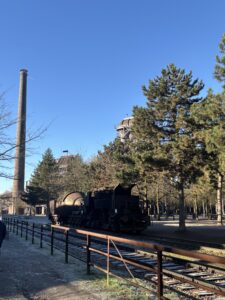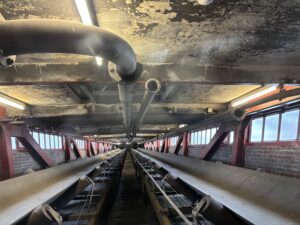The Steel City of Germany

A week after we arrived in Bonn, we took a trip to Duisburg, a city formerly known for being the leading steel and coal producer in Germany for most of the 20th century. Much of its former glory has been lost, with many of the coal and steel factories shutting down in more recent years due to environmental regulations, competition abroad, and the desire for modern, renewable forms of energy. When we first got to the city it immediately had a different feel than Bonn or Cologne; it had less of a commercial district, and less students and universities, as we were told by our tour guide. It reminded me of Bethlehem, another former steel producing city in Pennsylvania.
We started our day on Monday with a tour of a former steel plant, and though unfortunately because of the weather we couldn’t go up to see the blast furnaces up close, we could still see them from a distance and look at all of the elements in steel production. I found it really interesting how after the steel plant closed, many of the elements would be reused: for example, a diving club used a water tank that was used for many different processes such as descaling or cooling, and some of the walls had been converted into climbing walls for people to use. Another interesting thing I learned about this plant was that pretty much all blast furnaces, despite having certain requirements for them to work, were designed slightly differently, which could be seen in the multiple closed blast furnaces within the plant, and pictures of other blast furnaces in Germany and America that were displayed on the wall of the entrance building. This is an intriguing example of the creative aspect of engineering, and the freedom of design that engineers have with their projects.
The next day we went to a former coal mine and coke producing plant, the latter of which we didn’t get to see the inside of, but it was another interesting connection since coke is needed for the blast furnaces in the other plant to produce steel. Since most of the coal plant was inside, we had a better understanding of how many of the machines worked and the conditions of workers within the plant. The scale of the plant was very impressive, and is even cooler considering the maze of mines beneath the surface. As impractical as it is, I wish we could have gone down below to see all the mines. The amount of coal that was transported from the mines up to the processing plant was absurd, and we went to see the remnants of the carts and belts that helped with that process. Both of these plants were interesting to observe and I wish we could have gone up to see the blast furnace, but I still gained a new perspective on how important these plants were to Duisburg, and

the effect that closing them had on the city.
-Seamus B.
sources:
https://www.duisburg.de/microsites/visit_duisburg/discover_the_city/industrial_heritage/index.php
https://www.landschaftspark.de/en/industrial-heritage-circuit/denkmal-huttenwerk/
